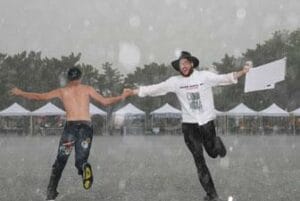By Stephen Huba, Post staff reporter
Twenty-three years ago, when the Lubavitcher first set foot here, most Jews in Cincinnati knew the movement only through its charismatic, New York-based rebbe, Rabbi Menachem M. Schneerson.
Now the Rebbe is gone, but the Lubavitch presence in Cincinnati is stronger than ever.
Their black attire, outreach programs and slick advertising have become a permanent, if controversial, fixture of Jewish life in this historically Reform town.
On Rosh Hashana, which begins at sundown Sunday, Chabad of Southern Ohio will dedicate its new FREE Russian Center, 7685 Reading Road, Roselawn.
Within the past seven years, Chabad has opened centers in Blue Ash, Loveland, Amberley Village, downtown Cincinnati and Dayton. Chabad operates a Hebrew school and summer camp, and offers services for virtually every aspect of Jewish ritual practice.
For the High Holy Days, Chabad offers training in shofar making, a crash course in Hebrew, challah baking classes, a full-color guide to the Jewish month of Tishrei, and a full schedule of worship services.
Chabad of Southern Ohio says it doesn’t keep membership records, but officials say the new centers are proof that their numbers are growing.
”They’re not offering a synagogue Judaism,” said Karla Goldman, assistant professor of Jewish history at Cincinnati’s Hebrew Union College. ”They’re offering a way of life that cuts away at all the ambivalence and ambiguity of modern life.”
Rabbi Yosef Kalmanson, executive director of Chabad’s Jewish Discovery Center in Golf Manor, said Chabad has had the most success with nonpracticing, unaffiliated Jews.
”The forefront of our work is to battle the issue of the vanishing American Jew,” said Rabbi Kalmanson, son of Chabad regional director Rabbi Sholom B. Kalmanson. ”The goal of Chabad is to bring people to understand more about Judaism (and) become more committed, without any pressure or any pushing.”
Chabad has its roots in the Hasidism, a 300-year-old Eastern European movement that stresses Judaism as a religion of the heart and of the common man. It downplays the necessity of strict Talmud study.
One brand of Hasidism became associated with the Russian town of Lubavitch. Chabad, another name for the Lubavitch movement, is an acronym from the Hebrew words for wisdom, understanding and knowledge.
Still, Chabad-Lubavitch remains a tiny minority in America, where most Jews are non-Orthodox.
”Their numbers don’t match their media presence,” Ms. Goldman said.
When Rabbi Sholom Kalmanson moved to Cincinnati with his family 1975, the first order of business was to set up a ”one-stop shop for anything Jewish,” his son said. The small Chabad House on Summit Road later became Congregation Lubavitch and the regional headquarters for Chabad of Southern Ohio.
Another priority was to help the city’s Russian Jewish immigrants, and soon the FREE Russian Center was established. FREE stands for Friends of Refugees of Eastern Europe. There are about 750 such families in Cincinnati.
”Chabad has played a very dynamic role with our Russian emigre community,” said Aubrey Herman, executive vice president of the Jewish Federation of Cincinnati. ”They complement the work of other agencies.”
But not all Jewish assessments of Chabad are glowing. Lubavitcher have been accused of being competitive, anachronistic and sectarian. Their claim to be the truest approach to Judaism clashes with the pluralism espoused by many American Jews, Ms. Goldman said.
”A lot of progressive Jews don’t want Americans to think that the Lubavitch type of Judaism is representative of American Judaism,” Ms. Goldman said.



